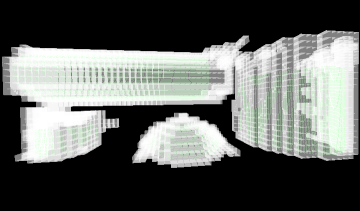conics.15887.pts |
|

|

|
| Figure 1: f(p)
at
marching cubes |
Figure 2: resultant triangles |
mechpart.4102.pts |
|

|

|
| Figure 3: f(p)
at
marching cubes |
Figure 4: resultant triangles |
- For each cube that intersects the signed distance function,
find the triangles formed by the cube/signed distance
function intersection:
- Using an STL
bitset<8> fbas the bit code for the cube, where each bit represents whether each vertex is above the surface (f(pi) is positive) or below it (f(pi) is negative), such that for eachkth vertex the bit value is:-
fb[k] = f(pi) >= 0.0 ? 1 : 0;
-
index = (int)fb.to_ulong();
cubeEdges = intersections[index];
intersectionslist (with -1 indicating no further records), e.g.,-
int intersections[484][7] = {
{-1,-1,-1,-1,-1,-1,-1},
{0,1,0,4,0,2,-1},
{1,5,1,0,1,3,-1},
{0,2,1,3,0,4,262},
{2,3,2,0,2,6,-1},
{0,1,2,6,2,3,264},
...
};
marchingCube.handmarchingCube.cpp. -
- For each of the three edges (three pairs of vertex
indeces i, j), calculate the point
of intersection along each edge:
- With each pair of verteces vi and vj, let t = -f(vi) / (f(vj) - f(vi)) (remember that f(pi) is stored at each vertex point).
- Return the interpolated intersection point p = vi + t (vj - vi).
- Add computed triangle to edge of triangles, calculating
the triangle normal as you do so by letting
u =
p1 -
p0,
v =
p2 -
p0,
and
n = cross(u,v)and normalizing. - Check to see if there is another 3-tuple intersection record to process (some cubes may produce 4 triangles).
- Using an STL
- You now should have a list of triangles (see Figure 2).
- Output your triangle data to a plain text file in the following
format:
tri[0].n
tri[0].p0
tri[0].p1
tri[0].p2
...
tri[n-1].n
tri[n-1].p0
tri[n-1].p1
tri[n-1].p2
where each of the triangles's verteces, tri[i].pj is a 3D point and tri[i].n is the triangle's (3D) surface normal. - Sample output can be found here: conics.15887.tris, mechpart.4102.tris.
- You can view your output with the
kdtreeprogram. Load your field file to view it. You can then check the "cubes" checkbox in the View menu to see the marching cubes with signed distance at each vertex. The program was last compiled on a Linux PC running Fedora Core 3 with g++ v3.4.3 and so should run on most of the FX net Linux boxes (but not on the Suns).
Usage:- left mouse: move camera in xy-plane (up/down, left/right)
- scroll mouse: truck in and out (along camera's view-axis)
- CTRL-left mouse: yaw/pitch camera
- CTRL-scroll mouse: roll camera
phase4.tar.gz) including:
READMEfile containing assignment and solution descriptions, e.g., program design, description of algorithm, etc., if appropriate.INSTALLfile containing any specific compliation quirks peculiar to your program, e.g.,
Compilation:make.USAGEfile containing any specific usage quirks peculiar to your program, e.g.,
Usage:./phase4 < conics.15887.ptswhere./phase4is the executable andconics.15887.ptsis the input.src/directory with source code.